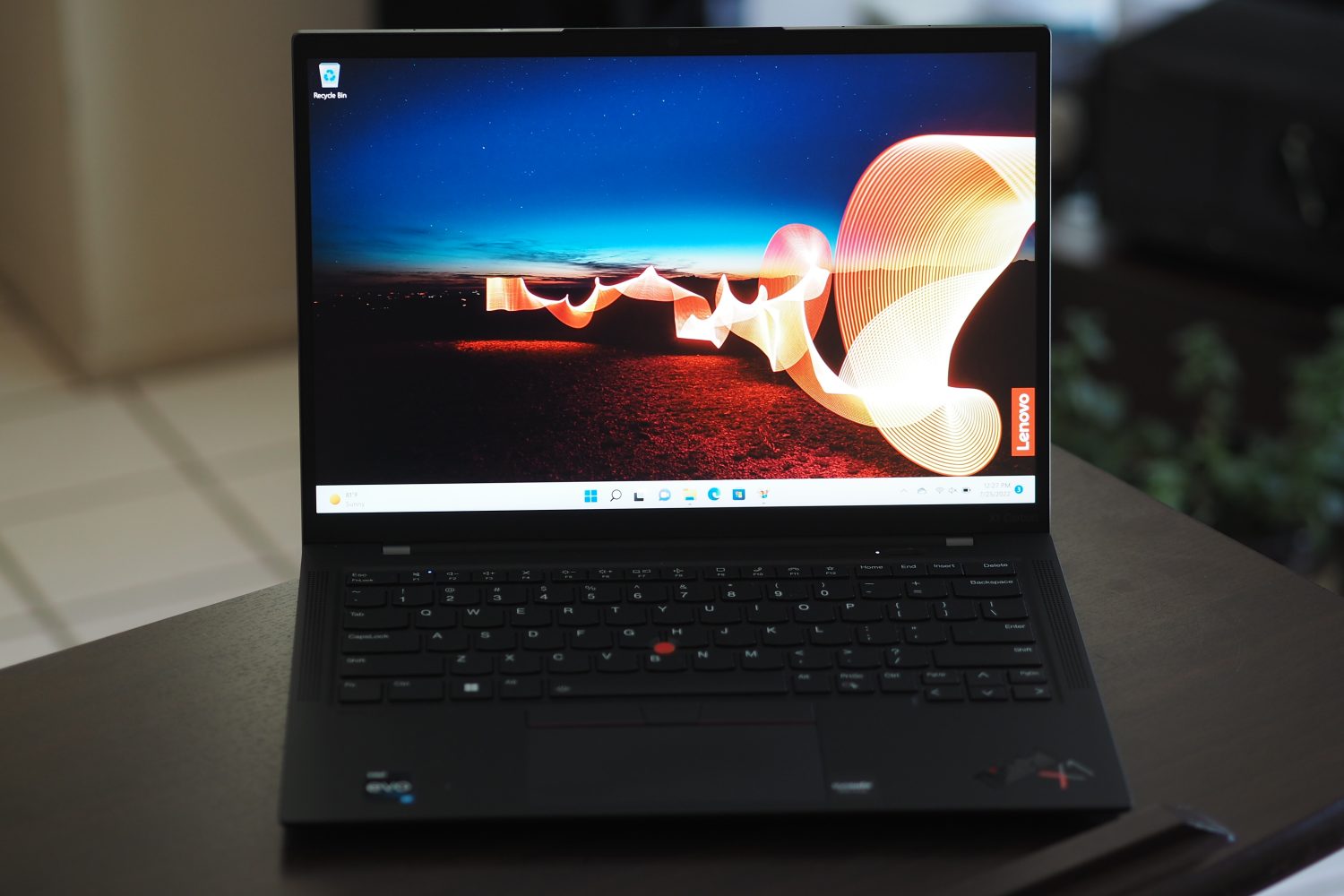

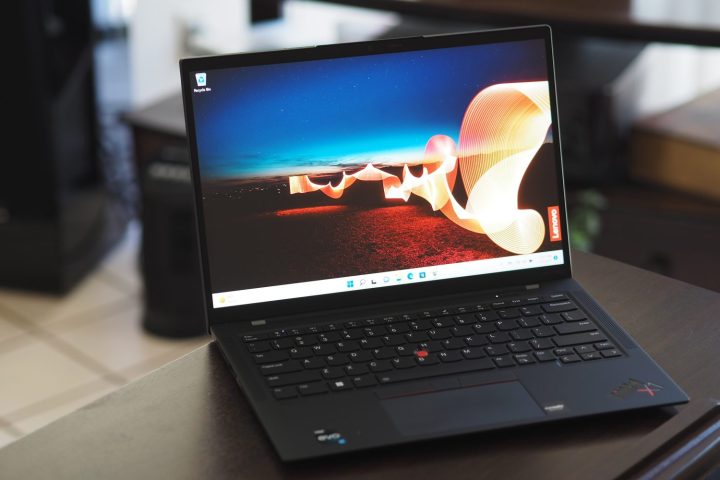
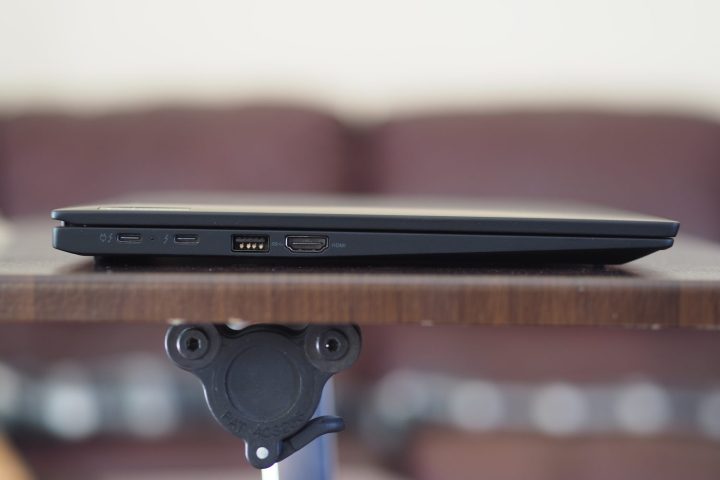
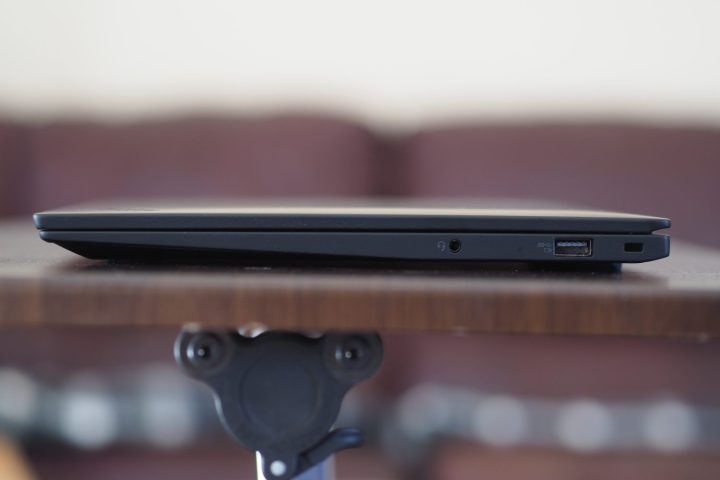
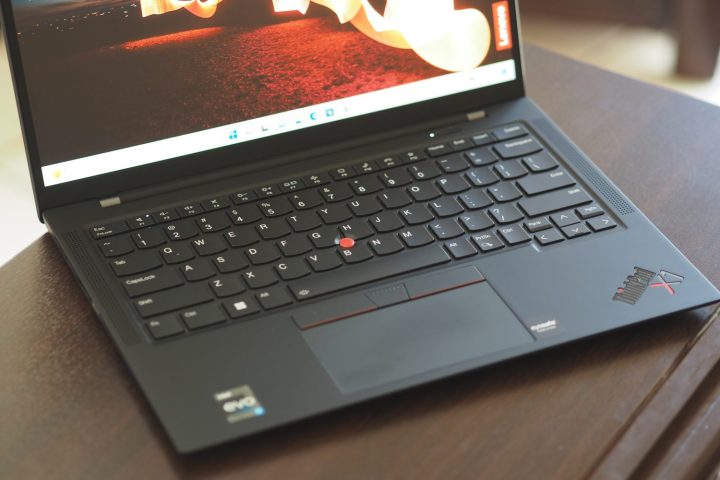
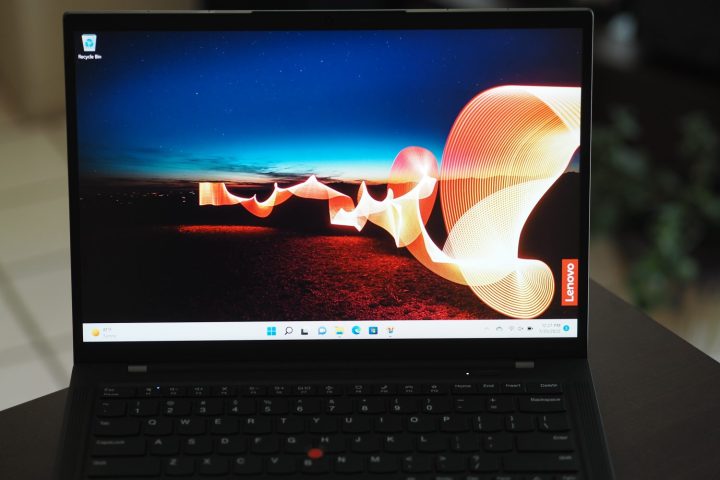

A laptop should be fairly refined by the time it’s hit its 10th generation. That’s particularly true with one as iconic as the Lenovo ThinkPad X1 Carbon, the company’s marquee business-oriented thin and light laptop.
Lenovo didn’t mark the X1 Carbon’s 10th generation with a spectacular reworking. Instead, it further refines the celebrated design with a few small but meaningful refinements, as it’s been doing in every generation since its launch.
These small tweaks, alongside an update to Intel’s 12th-gen CPUs, leave this premium business laptop at the top of its game, even if its price still doesn’t make it a particularly realistic mainstream consumer option.
Price and configurations

I reviewed a $1,680 configuration with a Core i7-1260P CPU and a 14-inch 16:10 UXWGA (1920 x 1200) low-power IPS display.
Of course, Lenovo provides several other configuration options with the ThinkPad X1 Carbon Gen 10. CPUs range from the 28-watt, 12-core/16-thread Core i5-1540P to the 28-watt 14-core/20-thread Core i7-1280P with vPro. As we’ll see in the display section below, there are a dizzying number of display options that make it possible (if challenging) to dial in precisely the desired efficiency and display resolution and quality.
Regarding pricing and using Lenovo’s configurator, things start at $1,320 for a Core i5-1540P, 8GB of LPDDR5 RAM, a 256GB PCIe SSD, and a 14-inch 16:10 WUXGA (1920 x 1200) low-power, anti-glare IPS display. At the high end, you’ll spend $2,595 for a Core i7-1280P with vPro, 32GB of RAM, a 2TB PCIe 4.0 SSD, 4G LTE, and a 14-inch 16:10 WQUXGA (3840 x 2400) anti-reflective, anti-smudge touch display.
These are steep discounts from the retail prices, and they aren’t out of line for the business audience that’s likely to be most interested in the ThinkPad X1 Carbon Gen 10. In terms of price, it’s less expensive than the more powerful Apple MacBook Pro 14 and around the same price as a similarly configured Lenovo ThinkPad X1 Yoga Gen 7.
Design

The ThinkPad X1 Carbon Gen 10 enjoys the same thin and light chassis as before, constructed of magnesium alloy in the chassis and carbon fiber in the lid. It’s subjected to the usual military testing for robustness as all ThinkPads. Still, like most laptops with magnesium and carbon fiber, there’s some bending in the lid and flexing in the keyboard deck.
In the ThinkPad’s case, though, it’s very minor and most people won’t notice it, but it doesn’t quite live up to the standards of more solid machines like the Dell XPS 15 and the MacBook Pro 14. The hinge is perfectly balanced, light enough to open the lid with one hand but stiff enough to hold the display in place.
The magnesium and carbon fiber do bring a meaningful benefit in terms of the ThinkPad’s weight, which comes in at just 2.48 pounds. It’s also thin at 0.60 inches, with larger bezels for a modern laptop and thus more width and depth than some.
By comparison, the solid aluminum MacBook Pro 14 with a 14.2-inch display weighs 3.5 pounds and is 0.61 inches thick, while being just slightly thinner and shallower in spite of the larger panel. The MSI Prestige 14, on the other hand, is a little wider and a little shallower while weighing a whopping 4.64 pounds and coming in at 0.63 inches thick. The ThinkPad X1 Carbon Gen 10 is one of the lighter 14-inch laptops around while being reasonably sized in all dimensions.
Aesthetically, what can I say? The ThinkPad X1 Carbon Gen 10 looks precisely like a ThinkPad — all-black chassis, minimalist lines and angles, red LED do on the stylized ThinkPad X1 logo on the lid and red TrackPoint nubbin in the middle of the keyboard. It’s a conservative, iconic design that’s recognizable from a distance. Ultimately, it’s more striking than simplistic machines like the Prestige 14 and Lenovo ThinkPad X1 Yoga Gen 7, while being less elegant than the MacBook Pro 14. But nobody will be embarrassed taking it into a business meeting.
Ports and connections


Connectivity is mostly solid for a 14-inch machine, with two USB-C ports with Thunderbolt 4 support, two USB-A 3.2 Gen 1 ports, a full-size HDMI 2.0b port, and a 3.5mm audio jack. There’s no SD card reader, which is disappointing.
Wi-Fi 6E and Bluetooth 5.2 provide the latest in wireless connectivity, and a Nano SIM slot is optional supporting 4G LTE WWAN.
Keyboard, touchpad, and webcam

The ThinkPad X1 Carbon Gen 10’s keyboard has slightly changed from the standard ThinkPad version. The keycaps are squared off, giving a more streamlined appearance and, in my opinion, a better feel. The switches seemed a bit lighter than many ThinkPads I’ve tested, and that’s an improvement in my book. I’ve usually found ThinkPad keyboards to require too much force. There’s still plenty of travel and a precise, snappy bottoming action, making it an excellent keyboard for long typing sessions. Lenovo also built air intake holes into the keyboard to improve thermal performance, and waterproof seals maintain the keyboard’s spill resistance. The layout remains the same, including the odd swapping of the left Fn and Ctrl keys.
The touchpad is wider than previous models and still hosts two buttons to support the red TrackPoint nubbin in the middle of the keyboard. That makes the touchpad slightly larger than in the past but still smaller than you’ll find on many competitive 14-inch laptops. Its glass surface is smooth and provides reliable support for Windows 11 multitouch gestures. And the TrackPoint works as well as ever for those ThinkPad diehards who prefer it.
Windows 11 Hello passwordless support is provided by a fingerprint reader built into the power button embedded in the deck above the keyboard. The power button’s placement helps avoid accidentally pressing the wrong key, and the fingerprint reader worked quickly and reliably in my testing.
Finally, the webcam is Full HD (1080p) and has a webcam privacy shutter. The webcam provides excellent video quality in normal and low-light environments and should meet anyone’s videoconferencing needs. There are options for a Full HD webcam with infrared for facial recognition and another with Lenovo’s Computer Vision technology.
Performance
Intel’s 12th-gen Core i7-1260P is our most-reviewed CPU over the last several months. It’s popular among thin and light laptops like the Carbon X1 Carbon, and we’ve seen some stratification in the chip’s performance. As a 28-watt, 12-core (four Performance and eight Efficient), 16-thread processor, the Core i7-1260P has provided at least solid productivity performance, but some laptops have performed better than others. The Acer Swift 3 2022 and MSI Prestige 14 are two laptops that provided overall superior performance than the average, while the ThinkPad X1 Carbon Gen 10 is among those providing significantly less performance.
That’s not a surprise given how previous models in the line have handled performance. This ThinkPad was particularly slow in our CPU-intensive benchmarks compared to competitors, including video encoding in Handbrake and the 3D rendering benchmark in Cinebench R23. The laptop’s PCMark 10 Complete result, a measure of a mix of productivity, multimedia, and creative tasks, was also lower than the average and even fell behind the 9th generation model with a Core i7-1165G7.
Oddly enough, I used Lenovo’s thermal management utility, and it performed worse in some tests in performance mode than in balanced mode.
Despite having a higher wattage chip inside, the ThinkPad X1 Carbon Gen 7 performed more like the Dell Inspiron 14 2-in-1 with a 15-watt, 10-core (two Performance and eight Efficient), 12-core Core i7-1255U. I can’t say that the ThinkPad suffered from any unusual issues with throttling, at least no more than the rest of the thin-and-light field, but it didn’t perform up to this CPU’s potential.
Of course, that doesn’t mean you’ll notice. It’s still a fast enough laptop for demanding productivity tasks, and it’s faster than Intel’s 11th-gen equivalents in most cases. But the ThinkPad’s ability to handle heavier tasks in creative applications is significantly less than with some other competitive machines.
| Geekbench (single / multi) |
Handbrake (seconds) |
Cinebench R23 (single / multi) |
PCMark 10 Complete |
|
| Lenovo ThinkPad X1 Carbon Gen 10 (Core i7-1260P) |
Bal: 1,531 / 8,209 Perf: 1,580 / 8,342 |
Bal: 133 Perf: 138 |
Bal: 1,538 / 6,993 Perf: 1,538 / 6,783 |
4,982 |
| Lenovo ThinkPad X1 Carbon Gen 9 (Core i7-1165G7) |
Bal: 1,327 / 5,201 Perf: 1,556 / 5,490 |
Bal: 170 Perf: 190 |
Bal: 1,469 / 4945 Perf: 1,463 / 4,968 |
5,147 |
| MSI Prestige 14 (Core i7-1260P) |
Bal: 1,505 / 10,041 Perf: 1,477 / 10,604 |
Bal: 114 Perf: 97 |
Bal: 1,553 / 8,734 Perf: 1,567 / 10,450 |
6,201 |
| Acer Swift 3 2022 (Core i7-1260P) |
Bal: 1,708 / 10,442 Perf: 1,694 / 10,382 |
Bal: 100 Perf: 98 |
Bal: 1,735 / 9,756 Perf: 1,779 / 10,165 |
5,545 |
| Lenovo ThinkPad X1 Yoga Gen 7 (Core i7-1260P) |
Bal: 1,650 / 8,080 Perf: 1,621 / 8,544 |
Bal: 116 Perf: 120 |
Bal: 1,587 / 7,682 Perf: 1,611 / 8,078 |
5,537 |
| MSI Summit E14 Flip (Core i7-1260P) |
Bal: 1,485 / 7,732 Perf: 1,472 / 10,276 |
Bal: 152 Perf: 94 |
Bal: 1,536 / 6,793 Perf: 1,536 / 9,124 |
4,910 |
| Dell Inspiron 14 2-in-1 (Core i7-1255U) |
Bal: 1,703 / 6,520 Perf: 1,685 / 6,791 |
Bal: 153 Perf: 141 |
Bal: 1,729 / 6,847 Perf: 1,773 / 7,009 |
5,138 |
| Asus Zenbook S 13 OLED (Ryzen 7 6800U) |
Bal: 1,417 / 6,854 Perf: 1,404 / 7,223 |
Bal: 112 Perf: 111 |
Bal: 1,402 / 8,682 Perf: 1,409 / 8,860 |
5,647 |
The ThinkPad X1 Carbon Gen 10 utilizes Intel’s Iris Xe graphics, and it was an average performer in both the 3DMark Time Spy benchmark and Fortnite at 1200p and epic graphics. You’ll want to limit your gaming to older titles and esports.
| 3DMark Time Spy |
Fortnite (1080p/1200p Epic) |
|
| Lenovo ThinkPad X1 Carbon Gen 10 (Intel Iris Xe) |
Bal: 1,816 Perf: 1,820 |
Bal: 17 fps Perf: 16 fps |
| MSI Prestige 14 (RTX 3050) |
Bal: 4,438 Perf: 4,451 |
Bal: 23 Perf: 26 |
| Acer Swift 3 2022 (Intel Iris Xe) |
Bal: 1,967 Perf: 1,967 |
Bal: 19 fps Perf: 19 fps |
| Lenovo ThinkPad X1 Yoga Gen 7 (Intel Iris Xe) |
Bal: 1,899 Perf: 1,886 |
Bal: 17 fps Perf: 16 fps |
| MSI Summit E14 Flip (Intel Iris Xe) |
Bal: 1,740 Perf: 1,959 |
Bal: 15 fps Perf: 19 fps |
| Dell Inspiron 14 2-in-1 (Intel Iris Xe) |
Bal: 1,492 Perf: 1,502 |
Bal: fps Perf: fps |
| Asus Zenbook S 13 OLED (Radeon graphics) |
Bal: 2,110 Perf: 2,213 |
Bal: 19 fps Perf: 19 fps |
Display and audio

Lenovo offers a mind-boggling assortment of display options for the ThinkPad X1 Carbon Gen 10. There are seven 14-inch 16:10 panels to choose from, differentiated by an alphabet soup of acronyms. First, there are three WUXGA (1920 x 1200) LP (low-power), AG (anti-glare) panels, one non-touch and two touch-enabled. One of the WUXGA displays with touch includes Lenovo’s Privacy Guard feature. Next is a 2.2K (2240 x 1400) AG IPS screen, followed by a 2.8K (2880 x 1800) OLED AGARAS (anti-glare, anti-reflection, anti-smudge) display. Finally, there are two WQUXA (3840 x 2400) IPS displays, one LP AG non-touch and one LP AOFT (Add-on Film Touch) AGARAS touch.
Whew.
My review unit was equipped with the WUXGA LP AG touch display, which seemed fine during my testing. It was plenty bright, colors seemed dynamic without being oversaturated, and blacks were deep for an IPS panel.
My colorimeter confirmed my subjective experience. The display hit 411 nits of brightness, which is well above our 300-nit threshold and more than bright enough for any indoor lighting condition you’re likely to face. Its contrast was also excellent at 1660:1, well about the 1000:1 we like to see in premium displays. That resulted in true blacks, for example, text that pops on a white background (my personal standard) and plenty of detail in dark images.
Colors hit the premium laptop average of 98% of sRGB and 76% of AdobeRGB, although I’ve seen more displays lately falling in the 80s for AdobeRGB. Color accuracy was okay at a DeltaE of 1.96, below the 2.0 mark that’s the minimum for creative work but still higher than I like to see. The MSI Summit E14 Flip and Lenovo ThinkPad X1 Yoga Gen 7 had wider and more accurate colors.
This is an excellent display for productivity workers and media consumers, but it falls short of what creators are looking for. However, Lenovo offers so many display options that certainly anybody can dial in a display that will meet their needs.
| Brightness (nits) |
Contrast | sRGB gamut | AdobeRGB gamut | Accuracy DeltaE (lower is better) |
|
| Lenovo ThinkPad X1 Carbon Gen 10 (IPS) |
411 | 1660:1 | 98% | 76% | 1.96 |
| MSI Prestige 14 (IPS) |
317 | 1820:1 | 97% | 72% | 3.67 |
| Lenovo ThinkPad X1 Yoga Gen 7 (IPS) |
386 | 1900:1 | 100% | 81% | 0.78 |
| MSI Summit E14 Flip (IPS) |
516 | 1320:1 | 100% | 89% | 1.10 |
| Lenovo Yoga 9i 14 Gen 7 (OLED) |
406 | 28380:1 | 100% | 95% | 0.87 |
| Lenovo IdeaPad Slim 7 Carbon (OLED) |
397 | 27590:1 | 100% | 96% | 0.88 |
Two downward-firing speakers put out a surprising amount of volume, and the quality was better than I expected. Along with clean mids and highs without distortion, I heard a touch of bass. The speakers were strong enough for Netflix binging sessions and informal music listening, although a good pair of headphones will still provide the best quality.
Battery life

My review unit used a 28-watt CPU and a low-power WUXGA (also known as Full HD+) display. Its 57 watt-hours of battery capacity is a little light for a 14-inch laptop, especially compared to the Lenovo Yoga 9i Gen 7 with its 75 watt-hour battery. I wasn’t expecting all-day battery life.
After running our suite of battery benchmarks, I came away mostly impressed. Its 7.5 hours in our web browsing test that cycles through a series of complex websites is about half an hour less than we like to see, but it was competitive among our comparison group. The Yoga 9i Gen 7 lasted longer, as did the Lenovo ThinkPad X1 Yoga Gen 7 (with 71 watt-hours) and the AMD-equipped Asus ZenBook S 13 OLED with a power-hungry display. Even so, the ThinkPad did okay. In our video test that loops a local Full HD Avengers trailer, it lasted for 14.5 hours, a strong score likely thanks to its low-power display. And finally, in the PCMark 10 Applications test that’s the best indication of productivity battery life, the ThinkPad X1 Carbon Gen 10 made it to 10.75 hours, an above-average result.
Overall, the ThinkPad’s battery life is pretty good, promising a full day’s work unless you push the CPU. You’ll get less out of some of the available higher-resolution displays as well as the OLED option, but stick with this display and you won’t need to carry your charger with you.
| Web browsing | Video | PCMark 10 Applications |
|
| Lenovo ThinkPad X1 Carbon Gen 10 (Core i7-1260P) |
7 hours, 39 minutes | 14 hours, 34 minutes | 10 hours, 42 minutes |
| MSI Prestige 14 (Core i7-1260P) |
5 hours, 11 minutes | 6 hours, 2 minutes | 7 hours, 2 minutes |
| Lenovo ThinkPad X1 Yoga Gen 7 (Core i7-1260P) |
10 hours, 10 minutes | 16 hours, 12 minutes | 10 hours, 33 minutes |
| MSI Summit E14 Flip (Core i7-1260P) |
7 hours, 23 minutes | 9 hours, 0 minutes | 7 hours, 54 minutes |
| Lenovo Yoga 9i 14 Gen 7 (Core i7-1260P) |
9 hours, 10 minutes | 12 hours, 45 minutes | 8 hours, 32 minutes |
| Dell Inspiron 14 2-in-1 (Core i7-1255U) |
6 hours, 42 minutes | 11 hours, 6 minutes | 8 hours, 43 minutes |
| Asus Zenbook S 13 OLED (Ryzen 7 6800U) |
8 hours, 4 minutes | 13 hours, 13 minutes | N/A |
Our take
The Lenovo ThinkPad X1 Carbon Gen 10 is a well-built and highly configurable laptop with options for the kind of management and security that businesses crave. For that audience, it’s a solid offering at a fair price.
For anyone else, the ThinkPad’s performance is lacking and it doesn’t offer as much to justify its high price. ThinkPad fans will love it, but other mainstream buyers should do their shopping first.
Are there any alternatives?
Dell’s Latitude 7430 is a likely alternative for the business market, offering similar management and security and a similar pricing scheme. It doesn’t offer the same breadth of display offerings as the ThinkPad.
Lenovo’s Yoga 9i Gen 7 is a strong competitor for the mainstream market, offering a more stunning design, the flexibility of a 2-in-1, better performance, and similar battery life. It costs a bit less as well.
Finally, Apple’s MacBook Pro 14 is a compelling option that’s exceptionally well-built and offers superior performance and battery life. It offers just one display option, but it’s as good as anything Lenovo has to offer. You’ll spend a bit more at the high end, though.
How long will it last?
The ThinkPad X1 Carbon Gen 10 is well-built and should last for years of typical abuse. Its components are fully updated and will keep Windows 11 humming along. I’m glad to see the three-year warranty, which should be included with all business class and premium laptops.
Should you buy it?
Yes, if you’re a businessperson who will benefit from plugging into an enterprise environment or a ThinkPad fan who’s looking for the latest and greatest.
Digital Trend, New tech, tech news, wikiHow

No comments:
Post a Comment